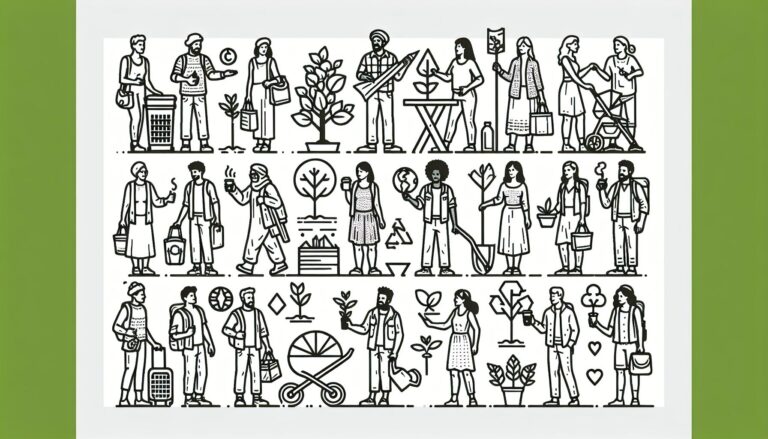When it comes to shopping for eco-friendly products, it’s essential to cut through the greenwashing and truly understand what makes a product environmentally friendly. As someone passionate about sustainability, I’ve learned to look beyond the flashy labels and dive into the details to identify truly eco-conscious items.
In this article, I’ll share my expert tips on how to distinguish genuinely sustainable products from those that just claim to be. From checking certifications to examining the materials used, I’ll guide you through the process of making informed and eco-conscious purchasing decisions. Let’s empower ourselves to make a positive impact on the planet by choosing products that align with our values and contribute to a greener future.
Understanding Eco-Friendly Claims
When assessing the eco-friendliness of a product, it’s crucial to scrutinize the various claims made by manufacturers. Here are some key points to consider:
- Look for specific certifications such as the Forest Stewardship Council (FSC) or Cradle to Cradle (C2C) to ensure legitimacy.
- Avoid vague terms like “green” or “natural” as they may not hold much weight without concrete evidence.
- Pay attention to third-party certifications, as they offer unbiased evaluations of a product’s environmental impact.
- Keep an eye out for transparency in the supply chain and manufacturing process – a truly eco-friendly product should be able to trace its origins.
By delving into the details of these eco-friendly claims, I can make more informed decisions that align with my values.
Researching Certifications and Labels
When researching eco-friendly products, one crucial aspect is certifications and labels. These third-party certifications serve as trustworthy indicators of a product’s environmental claims. Some key certifications to look out for include:
| Certification | Description |
|---|---|
| Forest Stewardship Council (FSC) | Ensures sustainable forestry practices and responsible wood sourcing. |
| Cradle to Cradle (C2C) | Focuses on circular economy principles and product lifecycle assessments. |
Before making a purchase, I always check for these specific certifications on the product packaging or website. Verified eco-friendly products typically display these certifications prominently, making them easy for consumers to identify. Furthermore, I recommend verifying these certifications directly on the certifying body’s website for additional assurance.
In my experience, labels such as “green” or “natural” can be misleading, so relying solely on them may not guarantee the product’s eco-friendly status. By focusing on recognized certifications, I feel confident in my choices and contribute to a sustainable future.
Analyzing Materials and Production Methods
When it comes to identifying eco-friendly products, one crucial aspect to consider is the raw materials used and the production methods employed. Here’s how I analyze them:
- Materials: I always look for sustainably sourced materials like organic cotton, bamboo, or recycled plastic.
- Production Methods: I prefer products that are manufactured using energy-efficient processes and low-waste production techniques.
- Packaging: I pay attention to the packaging materials used. Biodegradable or recyclable packaging is a big plus.
- Fair Trade: Supporting products that are fair trade certified ensures that the workers involved are treated ethically.
- Transportation: I consider the product’s carbon footprint by choosing items that are locally sourced or shipped using eco-friendly methods.
By analyzing these aspects, I can make more informed decisions when selecting truly eco-friendly products that align with my values and contribute to a sustainable future.
Considering Longevity and End-of-Life Disposal
When assessing eco-friendly products, it’s vital to consider their longevity and end-of-life disposal. Here are some key points to keep in mind:
- Durability: Opt for products made from high-quality materials that are built to last. Investing in durable items reduces the need for frequent replacements, ultimately decreasing waste.
- Repairability: Choose products that are repairable instead of disposable. Items that can be easily repaired or refurbished extend their lifespan and reduce overall environmental impact.
- Recyclability: Look for products that are recyclable at the end of their life cycle. Selecting items made from recyclable materials helps close the loop on the recycling process and minimizes waste sent to landfills.
- Biodegradability: Prioritize products that are biodegradable when disposed of. Biodegradable materials break down naturally over time, reducing pollution and harm to the environment.
When evaluating eco-friendly products, I always consider their long-term impact and environmental footprint to make choices that align with sustainability goals. By focusing on longevity and end-of-life disposal practices, we can contribute to a more sustainable future.
Making Informed Purchase Decisions
When it comes to making informed purchase decisions, doing research is key. Look for products that are certified by recognized ecological labels. These labels indicate that the product meets certain environmental standards. Additionally, consider the materials used in the product. Opt for items made from natural, organic, or recycled materials as they have a lower environmental impact.
Another important factor to consider is the packaging. Choose products that come in minimal or recyclable packaging to reduce waste. Moreover, look into the manufacturing process of the product. Select items that are produced ethically and sustainably to support responsible business practices.
Furthermore, longevity plays a significant role in determining the eco-friendliness of a product. Items that are durable and designed for longevity generally have a lower environmental footprint as they reduce the need for frequent replacements.
By taking these factors into account, I can make informed purchase decisions that align with my sustainability goals and contribute to a greener future.
Key Takeaways
- Scrutinize eco-friendly claims by looking for specific certifications like Forest Stewardship Council (FSC) or Cradle to Cradle (C2C) and avoiding vague terms.
- Research thoroughly by checking for trustworthy certifications and labels such as FSC and C2C on product packaging or websites for genuine eco-friendly products.
- Analyze materials, production methods, and fair trade practices when selecting products, focusing on sustainability, recyclability, and ethical manufacturing.
- Consider the longevity, repairability, recyclability, and biodegradability of products to reduce waste and environmental impact.
- Make informed purchase decisions by choosing items certified by recognized ecological labels, made from sustainable materials, with minimal packaging, and supporting ethical manufacturing practices.
Conclusion
Choosing truly eco-friendly products involves thorough research and a conscious effort to support sustainable practices. By prioritizing items with recognized ecological certifications, opting for natural or recycled materials, and considering ethical manufacturing processes, we can make a positive impact on the environment. Sustainable purchasing decisions not only benefit our planet but also promote a greener future for generations to come. Remember, every small choice we make contributes to a larger movement towards a more eco-conscious society. Let’s continue to educate ourselves and make environmentally responsible choices to create a more sustainable world.



